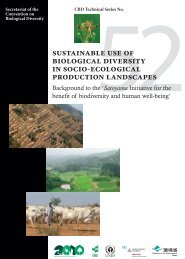INDIAN SCIENCE CONGRESS - India Environment Portal
INDIAN SCIENCE CONGRESS - India Environment Portal
INDIAN SCIENCE CONGRESS - India Environment Portal
You also want an ePaper? Increase the reach of your titles
YUMPU automatically turns print PDFs into web optimized ePapers that Google loves.
46<br />
Proc. 98th <strong>India</strong>n Science Congress, Part II : Abstracts of Symposium/Invited Lecture<br />
infection pattern than the type species G. riveae. Physiologically, variation in<br />
nutrient requirements in the haplophase is minimal, while nutrient requirements of<br />
dikaryophase is seemingly implicit in host specificity, while for those with a wide<br />
host range have apparent requirement.<br />
There is a variation in spore germination and germination products in smut<br />
fungi though basic germination pattern for Ustilaginaceae with phragmobasidium<br />
with lateral and terminal sporidia and Tilletiaceae with holobasidium with terminal<br />
sporidia is fixed. Conjugation of germination products is very frequent in Ustilaginales<br />
and very often basidial cells conjugate to establish dikaryophase. However, the<br />
species of Georgefischeria did not show conjugation of germination products.<br />
Variation in growth type and mutability of monosporidial colonies in culture are<br />
notable in smuts. Monosporidial colony growth is extremely slow in Georgefischeria<br />
riveae on 2% PDA and 2% HEA (host-extract-agar). The variations with different<br />
parameters in smuts are important and considerable mainly in taxonomy, phylogenetic<br />
studies, disease development.<br />
43. Understanding Life at High Temperature<br />
Ved Pal Singh<br />
Depatment of Botany<br />
Delhi University<br />
Keywords : Thermal envioronment,Radioactivity, Solar radiation<br />
The changing climate of the Mother Earth has left human civilization at the<br />
crossroad, which inculcates in us the desire to understand as to how to cope with<br />
harsh environments, especially the global warming. Thermal environments result<br />
from : (i) solar heating, (ii) combustion processes, (iii) radioactive decay, and (iv)<br />
geothermal activity. Although, in man-influenced environments, most of the heat<br />
generated comes from combustion processes (both biological and non-biological),<br />
but the contribution of radioactivity in heat production cannot be underestimated<br />
because of fast growing nuclear energy establishments all over the world. It is,<br />
therefore, imperative to have an insight into the mechanism(s), which could provide<br />
the basis for thermophilic existence of living beings, considering microbial model as<br />
a case study, since this is the only group which can withstand wide range of thermal<br />
environments. Most biomolecules, including enzymes, necessary for various meta-
















